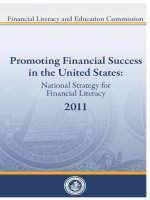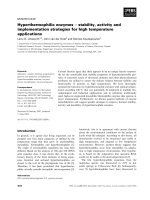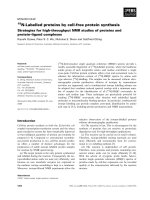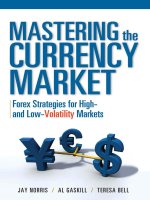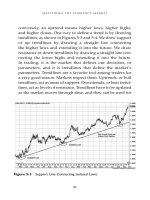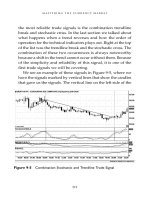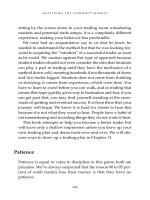Mastering the Currency Market Forex Strategies for High and Low_1 docx
Bạn đang xem bản rút gọn của tài liệu. Xem và tải ngay bản đầy đủ của tài liệu tại đây (432.35 KB, 32 trang )
MASTERING
the
CURRENCY
MARKET
This page intentionally left blank
MASTERING
the
CURRENCY
MARKET
Forex Strategies for High-
and Low-Volatility Markets
JAY NORRIS / AL GASKILL / TERESA BELL
New York Chicago San Francisco Lisbon London
Madrid Mexico City Milan New Delhi San Juan
Seoul Singapore Sydney Toronto
Copyright © 2010 by The McGraw-Hill Companies, Inc. All rights reserved. Except as permitted under the
United States Copyright Act of 1976, no part of this publication may be reproduced or distributed in any form
or by any means, or stored in a database or retrieval system, without the prior written permission of the pub-
lisher.
ISBN: 978-0-07-171370-2
MHID: 0-07-171370-0
The material in this eBook also appears in the print version of this title: ISBN: 978-0-07-163484-7,
MHID: 0-07-163484-3.
All trademarks are trademarks of their respective owners. Rather than put a trademark symbol after every
occurrence of a trademarked name, we use names in an editorial fashion only, and to the ben fit of the trade-
mark owner, with no intention of infringement of the trademark. Where such designations appear in this book,
they have been printed with initial caps.
McGraw-Hill eBooks are available at special quantity discounts to use as premiums and sales
promotions, or for use in corporate training programs. To contact a representative please e-mail us at bulk-
This publication is designed to provide accurate and authoritative information in regard to the subject matter
covered. It is sold with the understanding that the publisher is not engaged in rendering legal, accounting, or
other professional service. If legal advice or other expert assistance is required, the services of a competent
professional person should be sought.
—From a declaration of principles jointly adopted by a committee of the
American Bar Association and a committee of publishers.
TERMS OF USE
This is a copyrighted work and The McGraw-Hill Companies, Inc. (“McGraw-Hill”) and its licensors reserve
all rights in and to the work. Use of this work is subject to these terms. Except as permitted under the
Copyright Act of 1976 and the right to store and retrieve one copy of the work, you may not decompile, dis-
assemble, reverse engineer, reproduce, modify, create derivative works based upon, transmit, distribute, dis-
seminate, sell, publish or sublicense the work or any part of it without McGraw-Hill’s prior consent. You may
use the work for your own noncommercial and personal use; any other use of the work is strictly prohibited.
Your right to use the work may be terminated if you fail to comply with these terms.
THE WORK IS PROVIDED “AS IS.” McGRAW-HILL AND ITS LICENSORS MAKE NO GUARANTEES
OR WARRANTIES AS TO THE ACCURACY, ADEQUACY OR COMPLETENESS OF OR RESULTS TO
BE OBTAINED FROM USING THE WORK, INCLUDING ANY INFORMATION THAT CAN BE
ACCESSED THROUGH THE WORK VIA HYPERLINK OR OTHERWISE, AND EXPRESSLY DIS-
CLAIM ANY WARRANTY, EXPRESS OR IMPLIED, INCLUDING BUT NOT LIMITED TO IMPLIED
WARRANTIES OF MERCHANTABILITY OR FITNESS FOR A PARTICULAR PURPOSE. McGraw-Hill
and its licensors do not warrant or guarantee that the functions contained in the work will meet your require-
ments or that its operation will be uninterrupted or error free. Neither McGraw-Hill nor its licensors shall be
liable to you or anyone else for any inaccuracy, error or omission, regardless of cause, in the work or for any
damages resulting therefrom. McGraw-Hill has no responsibility for the content of any information accessed
through the work. Under no circumstances shall McGraw-Hill and/or its licensors be liable for any indirect,
incidental, spcial, punitive, consequential or similar damages that result from the use of or inability to use the
work, even if anyof them has been advised of the possbility of such damages. This mitation of liability shall
apply to any claim or cause whatsoever whether such claim or cause arises in contract, tort or otherwise.
v
Contents
PREFACE vii
PART 1
INTRODUCTION TO TR ADING CURRENCIES
1. TYPES OF FINANCIAL MARKETS 3
PART 2
FUNDAMENTAL ANALYSIS
2. THE WHY OF PRICE VALUATION 21
PART 3
TECHNICAL ANALYSIS
3. CHARTS FOR TR ADING 51
4. CANDLESTICK CHARTS 63
5. SUPPORT AND RESISTANCE 81
Contents
vi
6. CHART PATTERNS 125
7. TECHNICAL INDICATORS 153
8. TR ADING TECHNIQUES 187
9. TYING THE TECHNICAL INDICATORS TOGETHER:
TR ADE SIGNALS AND QUANTIFYING TRENDS 205
PART 4
TR ADING PHILOSOPHY
10. TR ADING PSYCHOLOGY 243
11. TR ADING THE APPROPRIATE TIME FR AME 251
PART 5
RISK MANAGEMENT
12. RISK AND MONEY MANAGEMENT 265
13. CREATING A TR ADING PLAN AND KEEPING
A TR ADING JOURNAL 275
CONCLUSION: MASTERING THE MARKETS 291
INDEX 295
vii
Preface
R
egardless of your level of economic or market knowledge,
the only way to learn how to trade the financial markets
successfully is to know the basics and practice using them reg-
ularly. We often hear clients say they already know the begin-
ning lessons and believe that the intermediate and advanced
lessons will make them successful traders. What we’ve found
in practice, however, is that most individuals lack a complete
understanding of the basics.
If you feel you are the exception to this rule, you may want to
consider the following questions: Have you written out a trad-
ing plan? Do you know the difference between a countertrend
signal and a trend signal? Do you understand the concept and
timing of buying strength and selling weakness? Do you know
that as an end-of-day trader, your risk-to-reward ratio is much
more favorable than that of a day trader? Do you understand
the difference between a leading and a lagging technical indica-
tor and know how and when to employ them? These are basic
lessons you need to know, and if you do not have them hard-
wired into your head, you very likely will not succeed at trad-
ing. Your success will depend on how seriously you take
yourself and trading. It’s fair to say that any profession that
Preface
viii
encourages the use of simulators should be taken seriously, and
trading is no exception.
The key in many top-earning professions is repetitive prac-
tice. Why do you think professional athlete practices as much as
they do? Why do you think a middle linebacker or a quarter-
back who makes millions of dollars a year practices basic foot-
work so often or why a concert pianist or violinist practices so
often? Conditioning is the answer. Professionals condition them-
selves to react physically the same way, every time, in various
situations regardless of their emotions. Professionals make the
time and take the effort to practice the basics because they know
they have to take themselves out of the process mentally to the
point where they don’t think, they just react. What may take
many years to learn lesson by lesson, with hours, then weeks,
and then years of practice, can be executed simply and flaw-
lessly without apparent effort when a professional is in the right
place at the right time. We are going to give you the tools and
the lessons you need and teach you how to recognize when the
time and place are right for you to execute your trading plan.
Why should you think that you can learn to trade when so
many people fail at it? Before you picked up this book, the odds
were only 1 in 10 that you would succeed. Regardless of how
you answered this question, the more important question is, Do
you really believe your answer? At the core of your being, do you
believe you can learn to trade successfully? That question is the
key, because until you possess a fundamental belief that you can
do it, you will not have the nerve to take the risks you need to
take at the times you need to take them to be a successful trader.
Beyond the psychology of trading, we are here to teach you a
trading method that once studied, back tested, and demo traded
will give you the confidence to both analyze markets and execute
trades successfully regardless of the underlying market condi-
tions. Becoming a successful trader gives you freedom. That
means that after completing this book and executing what you’ve
been taught, at the same time exhibiting both patience and dis-
cipline, you should be able to prove to yourself in a demonstra-
tion trading account that you have the knowledge and ability to
increase your account size consistently by trading the financial
markets. Once you prove this to yourself and become more com-
fortable with your new skills, there is virtually no limit to how
much you can earn over the coming years.
We are very confident in our teaching because of the experi-
ence that lies behind our method. In the early 1990s our head
trader, Al Gaskill, paid his first technical analysis instructor $5,000
a day to teach him how to use technical indicators. It was money
well spent. Over the years we have studied under some of the
best trading instructors in the business and always have walked
away with valuable knowledge. Whether it was dismissing
something that did not work for us or finding something that
did, it was always worth the cost of the lessons. Never has that
been clearer to us than in today’s volatile financial marketplace.
In 2008 we saw some of the most volatile markets ever in cur-
rency trading, but during that time Al had one of his best years
and his most productive period ever—August to October 2008—
by using the methods outlined in this book.
We feel very strongly that the currency markets constitute the
best trading vehicle in the financial markets right now and will
continue to do so. A currency pair is similar to a government
bill or note in that it pays or charges interest, depending on
whether you are long or short, on the basis of the underlying
countries’ short-term interest rates. A currency pair trades or
behaves like a stock pair, with those underlying interest rates
Preface
ix
acting as a dividend to traders holding the higher-yielding cur-
rency. From a trader’s perspective it is a better trading vehicle
than an individual country’s government securities because of
the low cost of entry afforded by margin, the dynamic pricing
resulting from the competitive marketplace, and the ease of
entry and exit. Though currency pairs trade or behave similarly
to international stock funds, the cost is much, much lower and
the overall risk is lower as well. We acknowledge that being
long or short the Australian dollar and simultaneously short or
long the Japanese yen can be a risky endeavor, particularly on
margin; however, we always encourage the use of stop-loss
orders, and in comparison to stocks, you don’t have to worry
about a currency pair evaporating, as happened to some of the
old-guard Wall Street firms that were trading stocks in 2008.
With the leveling out of international markets by globaliza-
tion and the increased level of competition this has bred, the
growth of trading in the foreign exchange market—forex—is
virtually assured as both professional and retail investors real-
ize the advantages of this market over investing and trading
traditional stocks, stock indexes, and securities markets.
You will learn that to be a successful trader is to be a man or
woman for all seasons. It means independence, but more than
that it means having a quiet confidence in what the future
holds. Well-rounded traders know they can make money
regardless of the underlying fundamentals or overriding real-
ities. The more volatile markets become—that is, the faster a
market moves—the faster a trader can make money. Equally,
when a market slows down, a trader downshifts to coun-
tertrending methods. Regardless of the certainty or uncertainty
of economic conditions, markets will move and astute traders
will benefit. With so many experienced financial leaders and
Preface
x
commentators pointing to a sustained recession for years to
come, it is not a question of whether traders will be successful;
it is a matter of how successful in light of the levels of economic
uncertainty in the current financial marketplace.
There is definitely a dark side to trading. People lose, and
losing is stressful. Trading certainly can be stressful, but when
it is taught in a supportive environment, studied thoroughly,
and practiced on a regular basis, the decision-making process
involved in trading can be a healthy development. The way to
avoid the stress and ease the learning curve for as long as it
takes, is to demo trade: open a practice or simulation account.
We highly recommend that you open a demonstration account
and promise yourself that you will not risk live money until
you’ve proved to yourself that you consistently can show a
profit in the demo account. When you get to that point of con-
sistency, you will have shown a level of patience and discipline
that can pay handsome dividends not just in trading but in life.
Before you venture too far into this book, we need to cover
the physiological impact trading will have. Your nervous sys-
tem is going to work against you as a trader. As part of our phys-
ical makeup, we all have what is called the autonomic nervous
system, which regulates subconscious biological functions such
as heartbeat, digestive processes, perspiration, and vision.
Within the autonomic nervous system are the sympathetic and
parasympathetic branches. The sympathetic branch is what we
rely on when we are angry or afraid. It is what increases our
heartbeat and adrenaline flow during times of stress, making us
literally jumpy. This physical change is also what we call the
fight or flight response, which was useful 10,000 years ago when
people lived in caves but today can make for a very tough learn-
ing environment. The excitement of making seemingly easy
Preface
xi
money, followed, sometimes just seconds later, by fear of loss
and failure will break most people down quickly. The emotional
ups and downs we create in our minds, followed by the physi-
cal changes in our blood pressure and adrenal glands, make for
a tough environment in which to learn and then retain knowl-
edge. The automatic fight or flight response hardwired into your
head will work against you as a trader. There will be times when
you click the mouse to enter or exit a trade and instantly ask
yourself, “Why did I do that?” because you realize you are not
following your trading plan. Before you get angry at yourself,
realize that you are not the only trader who ever let emotion
override logic. In fact, you are programmed to react that way.
Luckily for us, along with the fight or flight function regu-
lated by the sympathetic branch of the autonomic nervous sys-
tem, there is the parasympathetic branch, which can have a
calming effect on us and our bodies. It is this sympathetic
branch that we want to stimulate as we are learning and
studying trading lessons. You will get the most out of this
book by studying it in a relaxed and pleasant atmosphere. If
you currently are trading, you should consider taking a break
from it while you study this material. Learn what stimulates
the sympathetic branch of the autonomic nervous system and
engage in that activity before studying this material and again
afterward. Get in the habit of taking care of your mind and
body in this way until it is habitual. You will find that by tak-
ing the time to put yourself in a relaxed, meditative state
before starting your day and again before quitting in the eve-
ning, you will remain much calmer and more focused than the
millions of other people online who are risking their hard-
earned money every day in the marketplace.
J
AY
N
ORRIS
Preface
xii
MASTERING
the
CURRENCY
MARKET
PART
INTRODUCTION
TO TR ADING
CURRENCIES
1
CHAPTER
TYPES OF FINANCIAL
MARKETS
M
arkets generally are classified by type. The capital mar-
kets consist of the stock and bond markets, which have
instruments that may be traded on the New York Stock
Exchange (NYSE). There are also commodities and derivatives
markets, which feature financial products that are based on the
underlying commodities and are traded on central exchanges
such as the Chicago Mercantile Exchange. The markets on
which this book will focus are the financial markets, the
foreign exchange market, or forex, in particular.
Risk versus Reward
Before beginning an investing or trading program, it is very
important to understand the concept of risk versus reward. All
investments carry some degree of risk; there is no such thing
as a zero-risk investment. Higher potential rewards almost
always are coupled with higher risk. Figure 1-1 shows an
3
1
investment spectrum of low-risk and high-risk options. The
markets this book will cover are considered a high-risk invest-
ment. We do not recommend a high-risk investment strategy
for any money you cannot afford to lose. Risk can include fac-
tors, such as inflation and recessions, that affect the value of
what you are holding.
Methods That Apply to Multiple Markets
The methods we will be discussing apply to all markets,
including stocks, bonds, futures, options, and forex. Because of
the liquidity of the international currency markets, the low cost
of entry, and the advent of easy-to-use platforms and free chart-
ing packages, along with mini and micro contracts, most of the
examples we give will be in the forex markets.
Foreign Currency Trading
Foreign currency trading on a retail level was the brainchild of
Leo Melamed, chairman emeritus of the Chicago Mercantile
Exchange, with encouragement from the economist and Nobel
Mastering the Currency Market
4
Low Risk Limited Risk Moderate Risk High Risk
Treasury Bonds Blue Chip Stocks Growth Stocks Futures
Treasury Bills High-Rated Low-Rated Speculative
Corporate Bonds Corporate Bonds Stocks
Bank CDs High-Rated International High-Yield
Municipal Bonds Investments Bonds
Money Market Balanced Mutual Forex
Funds Funds
Figure 1-1 Risk Aversion Table
laureate Milton Friedman. In 1972 the Chicago Mercantile
Exchange started trading futures that were based on the
exchange rate between the U.S. dollar and other major curren-
cies, and the growth in financial derivatives has not slowed
since that time.
Foreign exchange trading was nothing new to banks and large
institutions, and it wasn’t long before brokers and dealers
around the world devised ways to make markets outside the
central location of the futures market in Chicago. The name forex
is an abbreviation for the words “foreign exchange.” Worldwide,
the forex market is the most actively traded financial market. The
daily volume on the forex market is equal to three to four times
that of all other markets combined, with an average daily turn-
over of $3.2 trillion. Forex is an extremely liquid market because
of the high level of participation, or high volume, and the fact
that currencies have a tendency to move in sustained trends rel-
ative to other markets or investments. Liquidity is important if
one wants to be able to get in and out of a market quickly, and
when we study trending markets, you will see that strong trends
represent opportunities to make a lot of money if you are on the
right side of the trade. Forex is traded 24 hours a day during the
workweek, closing Friday at 5 p.m. Eastern Standard Time and
reopening Sunday at 5 p.m. Forex also has a low cost of entry;
an investor can open an account with as little as $250.
Currency Trading History
Here are the highlights of the history of currency trading.
• When currency systems were introduced, a country’s
currency value was set against a gold standard.
types of financial markets
5
• In times of rapid political and economic change, the gold
standard becomes a problem. Therefore, after World War
I and World War II, many countries abandoned the gold
standard and adopted the Bretton Woods Accord.
• Between 1944 and 1971, exchange rates for foreign
currencies were set at a price fixed against the U.S. dollar.
• In December 1971, the Bretton Woods Accord that had
established the fixed rates was abandoned, and several
other systems were implemented briefly before a floating
exchange system was established.
• In 1972, the Chicago Mercantile Exchange starting trading
currency futures.
• At present, the currencies of most countries are valued
relative to the value of other currencies.
• With the expansion of the World Wide Web, the forex
market has been opened to include speculators and
private investors.
Forex Basics
As we mentioned previously, the forex market is traded
24 hours a day during the workweek and closes on Friday at
5 p.m. EST. Figure 1-2 shows the opening and closing times.
The hours are adjusted in the United States during Daylight
Savings Time.
What Is Traded on Forex?
Almost all the transactions on the forex market involve cur-
rency pairs. However, it is possible to trade precious metals
through most foreign exchange dealers.
Mastering the Currency Market
6
The Six Majors
The most commonly traded currency pairs on the forex market
are called the six majors. They are the British pound (GBPUSD,
also known as “sterling” or the “cable”), the Canadian dollar
(USDCAD, aka the “looney”), the Australian dollar (AUDUSD,
aka the “Aussie”), the Japanese yen (USDJPY, aka the “yen”), the
euro (EURUSD, aka the “fiber”), and the Swiss franc (USDCHF,
aka the “Swissy” or “chief”) (see Figure 1-3).
Distribution by Currency Pair
It is estimated that the U.S. dollar is involved in over 70 per-
cent of all transactions on the forex markets. Figure 1-4 shows
the breakdown of volume traded for the major currency pairs.
Cross Currency Pairs
Cross currency pairs (see Figure 1-5) are those which do not
involve the U.S. dollar. They tend to trade at lower volume,
and the spreads are usually higher for these pairs than for the
types of financial markets
7
Figure 1-2 Global Trading Hours Schedule
Time Zone New York GMT
Tokyo Open 7:00 p.m. 0:00
Tokyo Close 4:00 a.m. 9:00
London Open 3:00 a.m. 8:00
London Close 12:00 p.m. 17:00
New York Open 8:00 a.m. 13:00
New York Close 5:00 p.m. 22:00
Mastering the Currency Market
8
Figure 1-3 Major Currency Pairs
Estimated Trading Volume by Currency Pair
All Others
26%
AUDUSD
4%
USDCAD
5%
USDCHF
4%
GBPUSD
15%
USDJPY
19%
EURUSD
27%
Figure 1-4 Approximate Volume Breakdown per Currency Pair
majors. An exception to this rule are pairs such as the euroyen
(EURJPY) and euroswiss (EURCHF), which offer tight spreads
and excellent trading opportunities. Examples of cross cur-
rency pairs include Canadian dollar/Japanese yen ϭ CADJPY,
New Zealand dollar/Japanese yen ϭ NZDJPY, euro/Japanese
yen ϭ EURJPY, and British pound/Japanese yen ϭ GBPJPY. In
Chapter 2 we discuss in more detail the contribution of the
major currencies to the global marketplace.
Understanding Currency Pairs
Currency prices are quoted relative to another currency’s price
as a result of constantly fluctuating values. In each currency
types of financial markets
9
Figure 1-5 Examples of Cross Currency Pairs
pair (see Figure 1-6), the first currency listed is the base currency
and always has a value of 1.0. The second currency listed is the
counter currency. For example, EURUSD is the value of the euro
expressed in U.S. dollars.
Understanding Currency Values
The following example shows how fluctuations affect currency
prices:
• USD/JPY 110.08 means that 1 U.S. dollar equals 110.08
Japanese yen.
• If the price moves to USD/JPY 111.08, it means that the
dollar has gotten stronger, as one could buy more yen
per dollar.
• Conversely, if the price moves to USD/JPY 109.08,
the dollar has gotten weaker, as it buys fewer yen
per dollar.
• Prices for the JPY are given to two decimal places,
but prices for all other currencies are given to four
decimal places.
Mastering the Currency Market
10
XXX / YYY
XXX is the “base” currency
and
YYY is the “counter” currency
Figure 1-6 Base Currency versus Counter Currency
What Is a Pip?
A pip (Figure 1-7) is the smallest value by which a currency
may fluctuate in the forex market. Pip stands for “price in per-
centage” and sometimes is referred to as a “tick.” Let us see
how this works.
• A move from EUR/USD 1.5555 to 1.5550 is referred to as a
5-pip move.
• A move from USD/JPY 113.00 to 113.05 also is referred to
as a 5-pip move, since the yen is recorded only out to two
decimal places.
It is a good idea to do the math and know what a pip
equates to in terms of the base currency one is trading. For
most scenarios, the pip is equal to 0.0001, or 0.01 percent. In
types of financial markets
11
Figure 1-7 Minimum Price Fluctuations
that case the formula is (0.0001/exchange rate) ϫ contract size
(see Figure 1-8).
Lot Sizes
A standard currency contract is referred to as a lot. Initially, lot
sizes were very large because currencies were traded only by
large financial institutions. As the “retail” sector of the forex
market opened up, the market came up with smaller units
called mini lots and micro lots. Figure 1-9 lists their values.
With the advent of smaller lot sizes, the market has been
opened up to a larger number of individuals.
Mastering the Currency Market
12
Sample PIP Calculation
Exchange rate ϭ 119.90
Lot size ϭ $100,000
(0.1/119.80) ϫ $100,000 ϭ $8.34 per pip
Figure 1-8 Pip Calculation to Determine Monetary Value
Standard $100,000
Mini $10,000
Micro $1,000
Figure 1-9 Forex Contract Sizes
